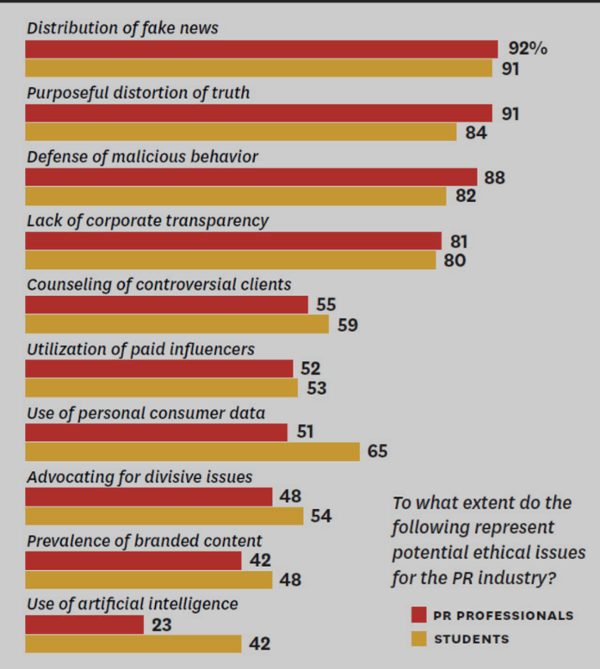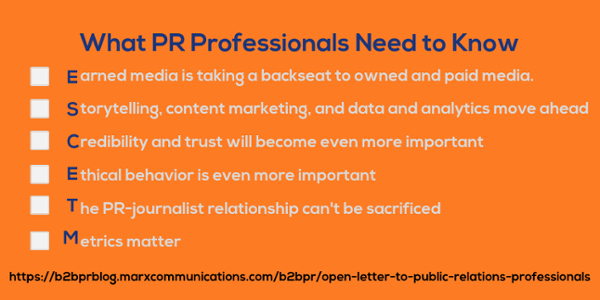Dear PR Professionals:
PR is evolving at warp speed. In fact, in five years, what we know as PR will have a different complexion.
Yet today, many PR professionals, armed with media placements and endless pitches, are still grounded in the past, since it’s so comfortable. Confession: I, a B2B PR agency owner, also have one foot still firmly planted in the past.
I have news for you. Looking ahead, earned media, a defining measure of PR for decades, will become a smaller and smaller part of what you do.
As noted in the 2018 Global Communications Report, “PR executives predict a decline of resources devoted to earned media over the next five years, as owned and paid media budgets continue to grow.”
The handwriting is on the wall. With that in mind, here are the messages PR practitioners need to see and take to heart if they want to remain relevant in the years to come.
What Public Relations Professionals Need To Know
Earned Media is Taking a Backseat to Owned and Paid Media. “The PR industry will have to adapt to a world in which the lines between paid, earned, owned and shared media are not only blurring, but largely irrelevant in the minds of consumers,” says Paul Holmes, founder of The Holmes Report and a partner in The Global Communications Report, a survey of 1,000 public relations leaders and students worldwide.
Source: 2018 Global Communications Report
Today, earned media represents 50% of a PR agency’s revenue, but over the next five years, according to the Communications Report, it’s expected to fall to 37%. The difference will be made up by shared (23%), owned (23%) and paid media (17%). In the corporate world, about one-third of budgets today are devoted to earned media. In the next five years, earned is expected to drop to 29% with paid, owned and shared media making up the difference.
PR pros who are laser-focused on earned media are digging their own grave. Start today (if you’re not already doing so) to widen your lens to encompass paid, owned and shared media.
Storytelling, Content Marketing, and Data and Analytics Come to the Fore. When asked what PR trends and tactics they rate as most important, the majority of the 223 communications professionals surveyed in the 2019 JOTW Communications Survey, cited storytelling (76%), data and analytics (75%), and content marketing (64%).
Rated less important: Press releases (33%), award programs (31%) and white papers (36%).
These ratings reflect the diminishing importance of earned media and the rise of owned, shared and paid media. PR professionals need to follow suit if they want to avoid becoming irrelevant.
Credibility and Trust Will Become Even More Important. In a world of fake news and a blurring of paid and earned media, PR professionals must exercise integrity and caution. “PR people need to apply even more rigorous standards of integrity and honesty to their work, whatever media they are using,” says Holmes.
Pitching will require a more judicious touch. Any ragtag outlet pitched to beef up media report statistics will no longer do. Less legitimate outlets are more likely to sensationalize a story to attract readers. PR pros can’t afford to risk any blemish staining a brand’s reputation.
At the same time, journalists, wanting to avoid any blowback from reporting fake news, will be extra picky in what they publish. The burden of proof will fall on PR professionals to ensure their stories are as authoritative as possible, buttressed by facts and supporting documents.
Ethical Behavior Is Even More Important. Fred Cook, of The Center for Public Relations, had this to say about ethical behavior: “As we witness every day, even the slightest hint of unethical behavior can result in permanent damage to the reputation of a company or an individual.”
As media outlets seek new revenue sources through branded content, the line between news and advertising has blurred. Branded content, if it poses as news, is ethically dicey. To protect themselves and their clients, public relations professionals need to ensure that any branded content is adequately labeled as such.
Fake news was rated the most challenging ethical threat by the 2018 Communications Report respondents.
The vast majority (92%) of professionals cited “fake news” as the most challenging ethical threat, followed by the purposeful distortion of the truth (91%). Defense of malicious behavior (88%) and lack of corporate transparency (81%) are also high on the list of potential ethical issues confronting communicators.
Source: 2018 Global Communications Report
The PR- Journalist Relationship Can’t Be Sacrificed Just because earned media’s importance wanes, it doesn’t give PR people a free pass to neglect journalists. We still need one another. It’s important to to find a way to work together and avoid disconnects like this one from The Washington Post, in which a company’s communications team declined to participate in a positive story about its brand by saying its executives were “too busy.” Certainly, companies have a right to decline to participate in a story. But there are better ways to decline. Offer to do something else for the reporter or direct him or her to someone else who can help.
Remember, like any relationship, the reporter-PR person connection, is a two way street. So many times, PR people pitch media only when they need coverage. I know I have done that. Yet, why not help a journalist when you aren’t pitching. As noted by seasoned journalist Rebecca Grant: “If you have a tip or an idea for an article that gasp doesn’t involve you, share it with a journalist. We are always on the prowl for good stories.”
Data And Metrics Matter. Fewer than half of the communications professionals surveyed in the 2019 JOTW Communications Survey reported having a measurement program in place. And only 29% said they do an adequate job with communications measurement.
The most common metrics communications pros say they track, according to the JOTW survey, are: web traffic (73%), impressions (66%), estimated site traffic (60%), company mentions (57%) and email open rates (52%).
These are focused on PR outcomes and outputs, not business outcomes. PR doesn’t have to be limited to those. Effective PR can move the needle in terms of search engine rankings, lead conversions, reviews, retention and revenues.
Yes, it’s not always easy to measure PR results. A starting point is to use tracking codes on links you share. That will let you know the source of people clicking on a link. There are low-budget and free tools that will help you put a measurement program in place. Companies like AirPR, Cision and TrendKite will clarify the performance of your PR assets and attach an ROI to them.
PR for too long has been a qualitatively-based profession masquerading as a quantitatively one. The problem is that the c-suite hasn’t believed the disguise. It’s time for PR professionals (and I am guilty as anyone else here) to remove the blinders. Not only do we need to embrace measurement fully. We need to adopt data mining and artificial intelligence to take the guesswork our of campaigns.
This post is meant as a wake up call for myself and other PR pros. It’s also an opportunity for PR to move to the forefront of communications and take its rightful place in the communications pantheon. Ready to join me? I’d love to hear your thoughts in the comments.
In review…


